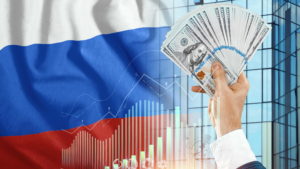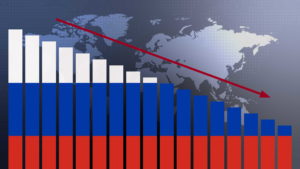The growth of Russian economy would expand at a greater rate than the economies of all the wealthy nations combined, including the US according to the IMF, a major international organization. This is the projection for this year. They predict 3.2% growth in Russia, which is far higher than they predict for major economies like the UK, France, and Germany.
According to Russia, the sanctions imposed by the West on its vital industries have strengthened the country’s ability to support itself, as seen by the determination of domestic investment and private consumption.
In addition, by continuing to sell commodities and oil to nations like China and India, the nation has been able to maintain strong revenue streams from its oil exports. Russia has been able to sustain its oil export earnings in part due to allegations of sanctions evasion and high oil prices.
The International Monetary Fund stated about Russia current economy,

“Steady oil exports and ongoing strong government spending had strengthened the Growth of Russian economy. They also emphasized how resilient the world economy has proven to be, even in the face of adversity. Despite worries, there was no global recession, banks continued to operate steadily, and significant emerging economies saw no abrupt downturns. Its growth projections for the majority of advanced economies for the upcoming year have generally been accurate to within a range of roughly 1.5 percentage points of the real result.”
IMF Report about Growth of the Russian economy and global economy

Here is the description of the IMF report,
The United States, the United Kingdom, the main countries of the euro area, Canada, and Japan are all categorized as advanced economies and major economies by the IMF. The IMF classifies Russia, China, and India as “emerging and developing” for Europe and Asia, respectively.
According to the baseline prediction, the global economy is anticipated to continue growing at a rate of 3.2 percent in 2024 and 2025, in line with 2023.
There will be a minor slowdown in emerging market and developing economies from 4.3 percent in 2023 to 4.2 percent in both 2024 and 2025, while major economies are expected to see a slight acceleration in growth from 1.6 percent in 2023 to 1.7 percent in 2024 and 1.8 percent in 2025. Looking ahead, the predicted rate of global growth in financial heights and other factors in five years is expected to be 3.1 percent, the lowest in decades.

Global inflation and financial heights are projected to gradually decrease, from 6.8% in 2023 to 5.9% in 2024 and 4.5% in 2025. Core inflation is predicted to drop more gradually in advanced economies, with emerging markets and developing nations expected to return to their inflation targets later.
Despite large increases in central bank interest rates intended to bring back price stability, the world economy has proven surprisingly resilient.
The immediate effects of policy rate hikes have been lessened by changes in the mortgage and housing markets during the decade before the pandemic, which was marked by low interest rates.

Regarding medium-term prospects, structural frictions that prevent labor and capital from migrating to productive enterprises are primarily responsible for the lower projected growth in production per person. As mentioned in Chapter 4, less optimistic growth outlooks for China and other major economies and developing market economies are also anticipated to affect trading partners.
Furthermore, Russia’s economy is similar to a war economy, with a large amount of state spending going into military manufacturing at the expense of consumption.
There are also worries about the difficulties the Russian economy is facing, such as the exodus of highly qualified professionals and restricted access to technology as a result of sanctions.













